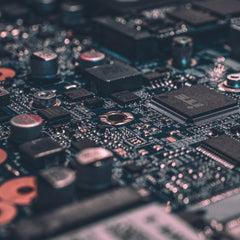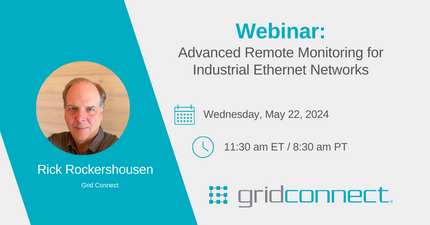Ethernet has done wonders for the factory environment by making it so control engineers have more autonomy and control over their industrial processes. By enabling more efficient communication between devices, managers can enjoy data-driven insights to optimize production and reduce operating costs. The introduction of industrial ethernet has made this much more achievable. Two of the most commonly-used ethernet-based protocols are EtherNet/IP and PROFINET. In this article, we will cover nine factors you should consider to help you choose the right protocol for your operation.
Industrial Compatibility. Factor 1
When choosing between EtherNet/IP and PROFINET, one should survey the existing devices on their network, as well as existing infrastructure. Oftentimes, geography plays a huge role in the types of devices on your network, which may make your decision easier.
Ethernet/IP
EtherNet/IP is an open standard protocol that is especially prominent in the manufacturing industry. It is especially prominent in Rockwell Automation (previously Allen-Bradley) devices. Rockwell Automation is the largest North American vendor of industrial devices, as well as devices produced by partnered vendors. This ensures that there is an adequate amount of vendor support for EtherNet/IP-enabled devices.
PROFINET
PROFINET is unique because it offers backwards compatibility with PROFIBUS, which allows for seamless transition from legacy PROFIBUS networks to PROFINET. Furthermore, while EtherNet/IP is a preferred protocol amongst devices produced by North American vendors, PROFINET is preferred amongst European vendors, such as Siemens. PROFINET has garnered significant support from many overseas device manufacturers.
Overall rating
EtherNet/IP Rating: ★★★★☆. The open standard approach makes EtherNet/IP highly compatible across devices, but PROFINET's ease of PROFIBUS migration gives it a certain edge, hence 4 stars.
PROFINET Rating: ★★★★★. PROFINET's high compatibility with legacy PROFIBUS systems and a range of industrial devices earn it 5 stars.
Scalability. Factor 2
The scalability of each protocol is contingent on your network infrastructure, the capabilities of your network switches, and network configuration. The choice between the two protocols depends on the specific requirements of the application, the size of the network, and the devices used.
Ethernet/IP
EtherNet/IP can support networks with thousands (yes, thousands) of devices. Ethernet/IP also utilizes standard Ethernet switches, which enables the creation of large and distributed networks with many switches and network segments. Ethernet/IP can handle substantial data throughput, accommodating data-intensive applications. For that reason, EtherNet/IP has been widely adopted across different industries, thus leading to a wide variety of compatible devices.
PROFINET
PROFINET is suitable for both medium and large networks, and can support a wide range of applications. PROFINET can efficiently handle ring and line topologies, providing flexibility in designing network architectures for different use cases. Perhaps the one feature that makes PROFINET stand out is its ability to integrate with existing PROFIBUS networks.
Overall rating
EtherNet/IP Rating: ★★★★★. With its large network size and high data throughput, EtherNet/IP gets a perfect score of 5 stars.
PROFINET Rating: ★★★★☆. PROFINET is highly scalable, particularly in applications requiring determinism, but falls slightly short of Ethernet/IP's data throughput, earning it 4 stars.
Vendor Support. Factor 3
Each of these protocols offer pretty good vendor support, but from different vendors, and predominantly on different continents. When considering industrial vendor support, it's essential to assess the availability of compatible devices, not to mention technical expertise.
Ethernet/IP
As mentioned previously, when you use EtherNet/IP, you can take advantage of an enormous North American ecosystem of industrial devices developed by Rockwell Automation and their partnered vendors. If you are a manufacturer in North America, there is a very good chance that you rely heavily on Rockwell devices. If so, EtherNet/IP is probably right for your operation.
PROFINET
Siemens has an enormous, global presence in the automation world. Because PROFINET was developed by Siemens, it has unmatched vendor support across a wide variety of different device categories and industries. If your operation is located in Europe or Asia, PROFINET is probably your best option.
Overall rating
EtherNet/IP Rating: ★★★★☆. Ethernet/IP, although strongly supported in North America, doesn't have as widespread support globally, earning it 4 stars.
PROFINET Rating: ★★★★★. With strong support from Siemens and a significant global presence, PROFINET gets a perfect 5-star rating.
Determinism and Real-time Performance. Factor 4
When choosing between the two protocols for applications with stringent determinism and real-time requirements, it's essential to consider the specific demands of the application, the devices used, and the network infrastructure. Here's a comparison of determinism and real-time performance between Ethernet/IP and PROFINET.
Ethernet/IP
CIP Sync
Ethernet/IP can achieve determinism and real-time performance through Common Industrial Protocol Synchronization (CIP Sync). This ensures accurate timekeeping and coordinated actions between devices.
Device Priority
EtherNet/IP prioritizes time-critical traffic through Quality of Service (QoS) mechanisms. This helps to minimize communication delays and ensure real-time performance.
Standard Ethernet Infrastructure
EtherNet/IP uses standard ethernet infrastructure, such as routers and switches. It should be noted that the determinism and real-time performance can be influenced by the quality and configuration of the network components.
PROFINET
Isochronous Real-Time (IRT) Communication
Isochronous Real-Time (IRT) communication ensures consistent and predictable communication cycles. For this reason, it is the preferred protocol for demanding real-time applications.
Time Synchronization
SImilar to CIP Sync, PROFINET uses the Precision Time Protocol (PTP) to synchronize clocks across the network. This allows for precise time coordination between devices on your network.
Device Priority and Channel Reservations
To ensure that critical communication is given top priority and reserved bandwidth for real-time transmission, PROFINET implements device priority and channel reservations.
Overall rating
EtherNet/IP Rating: ★★★★☆. While Ethernet/IP offers real-time capabilities, it does not have the same level of determinism as PROFINET, hence 4 stars.
PROFINET Rating: ★★★★★. PROFINET's Isochronous Real-Time (IRT) communication offers superior determinism, making it a 5-star contender.
Interoperability. Factor 5
Both EtherNet/IP and PROFIBUS offer pretty good interoperability. However, the way each of these protocols achieve interoperability differs. The following are three features of each protocol that allow them to achieve interoperability.
Ethernet/IP
Open Standard
EtherNet/IP easily integrates with IT systems and devices because it is based on standard Ethernet. This compatibility allows it to seamlessly integrate with a wide variety of IT and OT devices.
Common Industrial Protocol (CIP)
Ethernet/IP uses the Common Industrial Protocol (CIP). Devices using CIP share a unified communication framework. Other protocols that have adopted the CIP framework (such as DeviceNet and ControlNet) can seamlessly communicate with EtherNet/IP devices.
Vendor Ecosystem
Within EtherNet/IP’s enormous vendor ecosystem are a variety of device manufacturers that offer compatible devices, enhancing its interoperability in multi-vendor environments.
PROFINET
Backward Compatibility with PROFIBUS
PROFINET’S backward compatibility with PROFIBUS allows users to integrate PROFINET into existing PROFIBUS installations without a complete overhaul. This helps save time and resources (and prevent a few headaches as well).
Profile-Based Communication
PROFINET device profiles define the functionality of devices and their communication requirements. This ensures consistent behavior between devices of different manufacturers.
PROFIsafe Integration
PROFIsafe a safety communication protocol that is supported by PROFINET which allows for seamless integration of safety devices into your network. This is especially helpful for operations that require many safety-critical devices.
Overall rating
EtherNet/IP Rating: ★★★★★. Thanks to the Common Industrial Protocol (CIP) and standard Ethernet, EtherNet/IP earns 5 stars.
PROFINET Rating: ★★★★☆. PROFINET's interoperability is high due to backward compatibility with PROFIBUS, but the open standard of Ethernet/IP puts it slightly ahead, hence 4 stars.
Security. Factor 6
Both EtherNet/IP and PROFINET are packed with features that keep your network safe and secure. Specific security features and implementations may vary between the protocols. The following are some of the most important security features offered by each of the protocols.
Ethernet/IP
Port Security
Port security helps prevent unauthorized, malicious devices from connecting to your network and accessing valuable data.
Device Identity
Ethernet/IP allows devices to establish their identities using X.509 digital certificates, enhancing trust and preventing man-in-the-middle attacks.
CIP Security
CIP Security is a comprehensive security protocol that provides data confidentiality, integrity, and authenticity. This helps foster secure communication between devices through authentication and encryption.
PROFINET
PROFIsafe
PROFIsafe was designed to protect against safety-related malfunctions and failures. It is designed to meet stringent safety requirements so that your network needn't worry about your safety devices becoming compromised.
Topology-Based Security
PROFINET allows configuring access privileges based on network topology, restricting certain devices' access in specific segments. This gives managers more control over which devices can access specific data.
Access Control Lists (ACLs)
ACLs can be put in place to control which devices are allowed to communicate with specific PROFINET devices.
Overall rating
EtherNet/IP Rating: ★★★★☆. Ethernet/IP offers good security features, but its effectiveness will depend on the specific application needs, earning it 4 stars.
PROFINET Rating: ★★★★☆. PROFINET also presents strong security features, including Profisafe. Similar to EtherNet/IP, the rating will depend on specific security requirements, hence 4 stars.
Cost. Factor 7
The cost of using either EtherNet/IP or PROFINET depend on various factors, such as the specific application, network size, the industrial devices used, and the expertise available for installation and maintenance.
Ethernet/IP
Integration with IT Infrastructure
Because EtherNet/IP integrates seam;essly with IT infrastructure, you don’t have to invest in many (if any) additional devices to make this proverbial marriage work.
Device Compatibility
Because there is a wide range of manufacturers of compatible devices, you have the ability to price shop different vendors for the equipment you need. In other words, the more competition there is for your business, the lower the price might be for the devices you need.
Hardware Costs
EtherNet/IP uses standard ethernet components such as switches, cables, and network interface cards which are widely available and competitively priced.
PROFINET
Vendor Support
Having an international network of different device vendors, you can enjoy thorough vendor support, which helps keep overall costs low.
Device Compatibility
Because there are a multitude of different device manufacturers that support PROFINET, they must compete to earn your business. This is reflected by both the cost and quality of the devices on the market.
Hardware Costs
The hardware costs associated with the PROFINET protocol are comparable to that of EtherNet/IP. These components are readily available and inexpensive.
Overall rating
EtherNet/IP Rating: ★★★★☆. Potential cost savings through IT infrastructure integration give Ethernet/IP an advantage, but overall costs depend on hardware and compatibility needs, hence 4 stars.
PROFINET Rating: ★★★★☆. PROFINET also earns 4 stars. The overall expense depends on specific hardware and compatibility requirements.
Industry Acceptance. Factor 8
When evaluating the industry acceptance of Ethernet/IP and PROFINET, it's essential to consider the dominant players, the presence of vendor support, the number and types of devices available, and the historical usage in the specific industries where they will be deployed.
Ethernet/IP
EtherNet/IP has an enormous presence and vendor ecosystem in North America thanks to Rockwell Automation. EtherNet/IP has found a home in a variety of different applications, such as commonly used in sectors like discrete manufacturing, automotive, packaging, and material handling. This has also led to its integration into many different industries.
PROFINET
If your operation is located on the other side of the pond, you are likely using Siemens devices. Being the largest supplier of automation devices, it is no wonder PROFINET can offer unmatched vendor support in a variety of applications and industries. PROFINET's acceptance has also been boosted by its ability to coexist and be backward compatible with PROFIBUS.
Overall rating
EtherNet/IP Rating: ★★★★☆. Ethernet/IP has strong acceptance in the North American market and diverse industrial applications, earning it 4 stars.
PROFINET Rating: ★★★★★. PROFINET's robust global presence, PROFIBUS legacy, and vendor support earn it 5 stars.
Data Transfer Rates. Factor 9
When considering data transfer rates for a specific application, it's crucial to assess the communication requirements and the amount of data that needs to be exchanged in real-time.
Ethernet/IP
EtherNet/IP can support Gigabit ethernet and higher, which is ideal for large networks with high communication demands. This allows for extremely high data throughput. EtherNet/IP also can achieve real-time data communications, which provides clock synchronization and coordinated actions between devices. It should also be noted that some newer implementations might even support higher speeds such as 10 Gbps.
PROFINET
PROFINET can operate over Fast Ethernet (100 Mbps) and Gigabit Ethernet (1 Gbps) speeds. This makes it compatible for more demanding industrial applications. PROFINET also supports Isochronous Real-Time (IRT) communication. IRT ensures consistent, predictable communication cycles for time-critical data transfer.
Overall rating
EtherNet/IP Rating: ★★★★★. Supporting Gigabit Ethernet and above, Ethernet/IP's high data transfer rates earn it 5 stars.
PROFINET Rating: ★★★★☆. While PROFINET also supports high-speed data transfer, its rates are slightly lower than EtherNet/IP, hence 4 stars.
Which Protocol is Right for Me?
Now that we have analyzed the nine factors that you should consider before choosing between EtherNet/IP and PROFINET, let’s take a look at how each of the protocols stack up.
|
Feature |
EtherNet/IP |
PROFINET |
|---|---|---|
|
Industrial Compatibility |
★★★★☆ |
★★★★★ |
|
Scalability |
★★★★★ |
★★★★☆ |
|
Vendor Support |
★★★★☆ |
★★★★★ |
|
Determinism |
★★★★☆ |
★★★★★ |
|
Interoperability |
★★★★★ |
★★★★☆ |
|
Security |
★★★★☆ |
★★★★☆ |
|
Costs |
★★★★☆ |
★★★★☆ |
|
Industry Acceptance |
★★★★☆ |
★★★★★ |
|
Data Transfer Rates |
★★★★★ |
★★★★☆ |
The biggest, but not exclusive, deciding factors for your operation likely comes down to location and current devices. If you are located in North America and are using Rockwell-compatible devices, EtherNet/IP is probably best for you. Its speed and ability to interoperate using CIP makes it the ideal protocol for large and growing networks.
On the other hand, if you are a European or Asian manufacturer using Siemens devices, you are probably more inclined to use PROFINET. And if your operation still features legacy PROFIBUS devices, PROFINET’s seamless integration will make your life much easier. With unmatched vendor support and variety, PROFINET is one of the most accepted protocols across different industries.
Grid Connect Helps You Stay Connected
Unigate CL Fast Ethernet Gateway
If you are looking to adopt a faster, more scalable network with EtherNet/IP but are hesitant to replace a few important legacy devices, then you should use the Unigate CL 2-Port EtherNet/IP Gateway. This device allows you to connect any Modbus TCP or Modbus RTU device to your network using Ethernet. This is perfect for high-volume applications.






